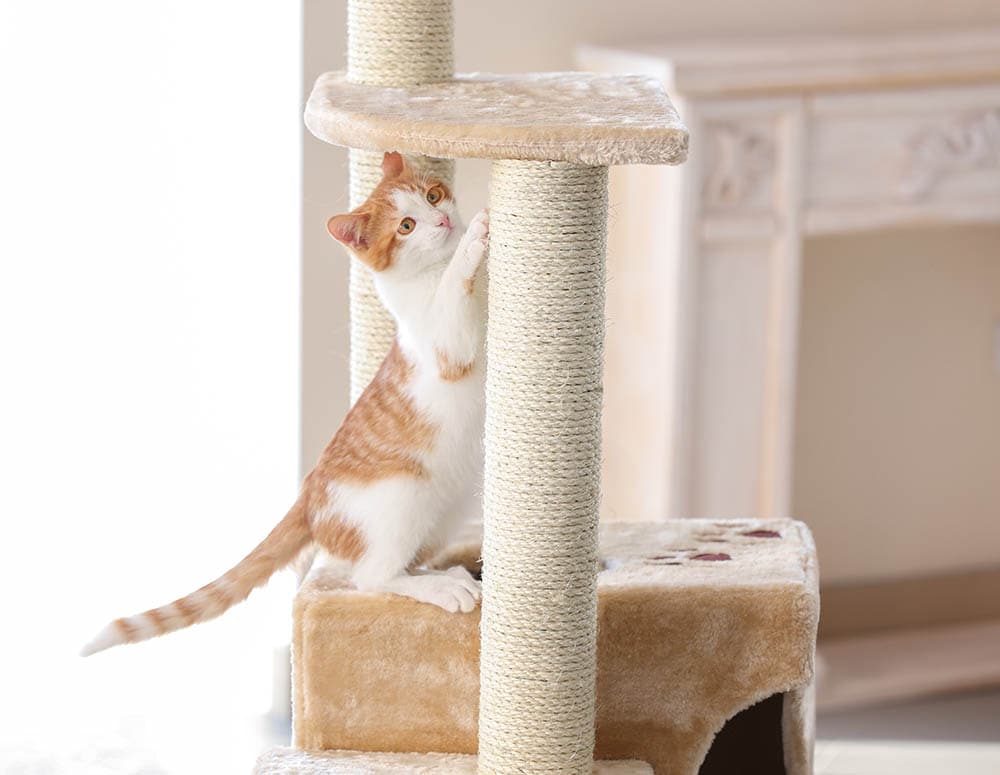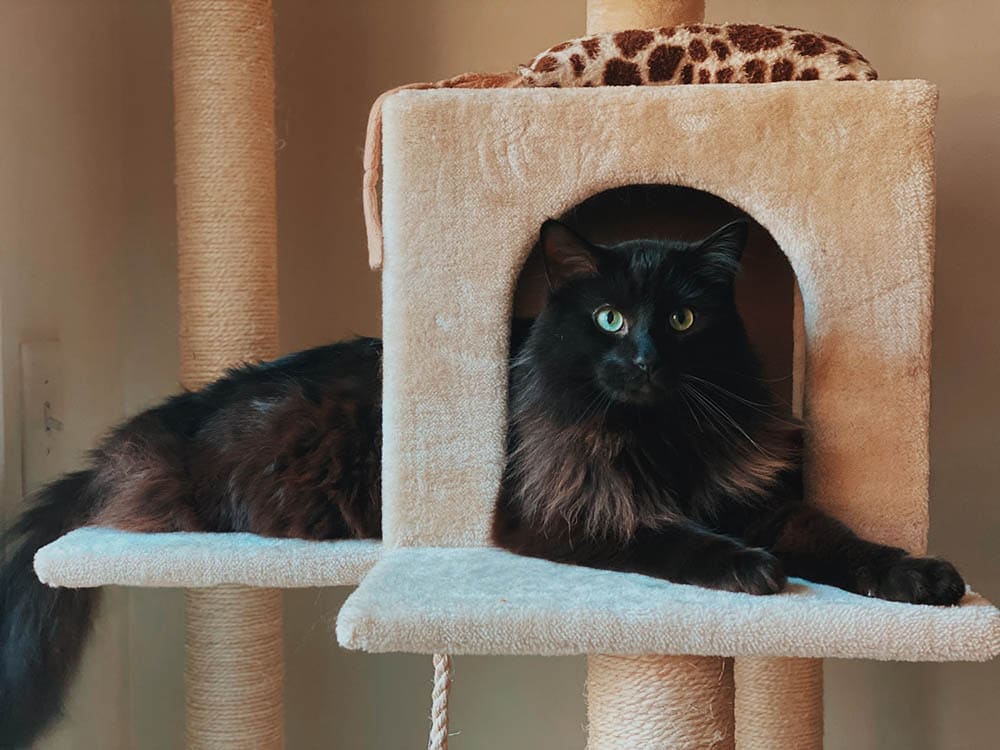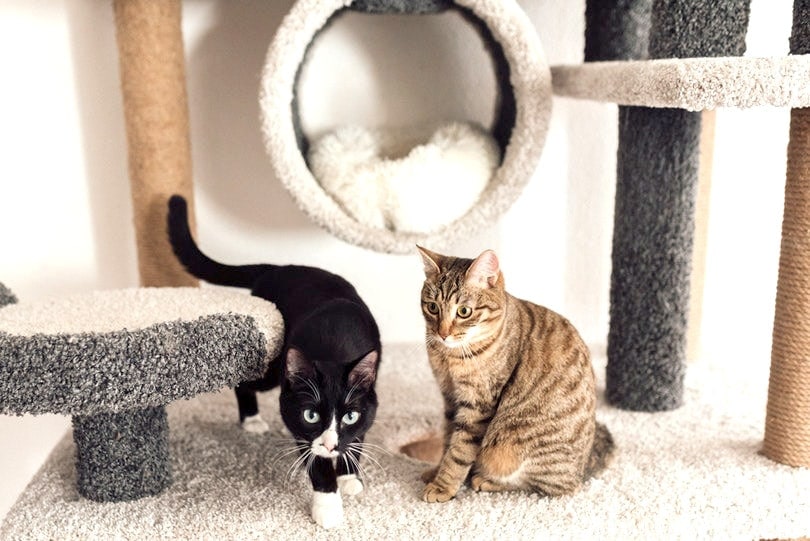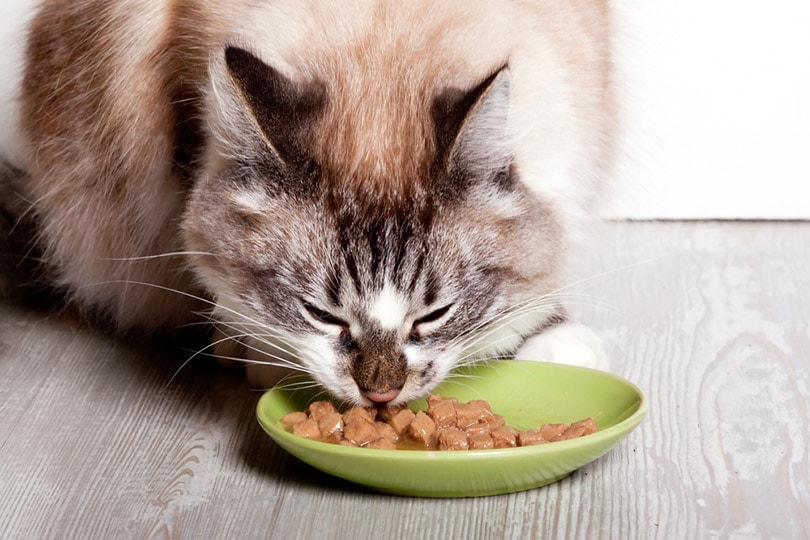How to Get a Cat to Use a Cat Tree (6 Possible Ways)

Updated on

Not only do cat trees help keep our furry felines off our furniture, but they also give them a scratching outlet and a nice, secure place to lounge.
If you have recently purchased a cat tree and you find yourself still struggling with scratched-up or hair-covered furniture, you are not alone. Cats do not always adjust well to changes in the household, even if they are specifically for their benefit. The good news? There are some things you can try to help convince your cat that their new tree is the place to be.
In this article, we will go over the reasons why your cat may not be using their cat tree and the steps you can take to teach them to use it.
Why Won’t My Cat Use Their Tree?
Cats are climbers by nature, if an indoor cat is avoiding a cat tree, something is going on that is preventing them from utilizing this handy piece of furniture. First and foremost, it’s important to understand what could be causing their distaste for the tree before implementing the steps to teach them how to use it.
Fear or Stress
Fear and stress typically go hand in hand. Cats are finicky creatures, and some individuals can be very sensitive to even the smallest changes that go on around them. Bringing in a new piece of furniture could cause them stress just because there is something new in their environment.
Your cat could also experience fear by the way the tree looks or if it has a negative experience associated with the tree, such as being kicked out of it by another feline roommate. Territorial issues are common in multiple-cat households. Once you identify the reason for the fear and/or stress, you can take steps to make them feel more relaxed and comfortable.

Lack of Mobility
Your cat may not be taking to the cat tree well simply because they have a lack of mobility that is related to age, health, or even confidence. Interestingly, some cats won’t jump or climb up to higher areas simply because they lack the confidence to do so. Cats with mobility issues may find it easier to avoid the tree altogether.
Undesirable Location
Location is a very important factor to consider if your cat is refusing to use the cat tree. Cats are picky and they tend to be location-specific. Some cats will undoubtedly prefer to be perched where the people are, while others like to slink away in peace and solitude. Most cats want a good view of what is going on around them as well, so windows are typically preferred.
You will notice that most cats have favorite areas in the house, if you place the tree in an area they hardly visit, that could be what is preventing them from enjoying their new tree.
The 6 Ways to Get a Cat to Use a Cat Tree
1. Find an Ideal Location
Cats are observant and typically want to frequent the areas where the rest of the family is active. Placing the cat tree in a location that is not frequented by other members of the household may not work out too well. You want to make the tree as convenient as possible. Having the tree in a good location with a good vantage point will only entice your cat to use it.
This is not a one-size-fits-all step, as each cat is different. What if you have a cat that likes to hide and keep away from the foot traffic in the house? This is where you will consider a more solitary cat’s most favorite locations around the house. If you feel your cat will not take well to high-traffic areas, try placing the tree in one of their most-frequented rooms or comfortable areas within the home.
Keep in mind that most cats love windows, a lot of cat owners are familiar with the damage they can cause to your blinds and screens. Placing the cat tree near a window for window-loving kitties is a great idea to encourage the use of the tree. Try to find a location that is ideal for both you and your cat to ensure everyone is happy.

2. Pick a Tree That Suits Your Cat(s)
Picking the ideal tree is one of the most important aspects of ensuring your cat will be willing to use the tree. You will need to pick a tree that works for the circumstances surrounding your cat.
- Number of Cats in the Home: If you have multiple cats in the home, you will need to keep this in mind when purchasing a tree. Ideally, all your cats get along and can share a tree, but we all know how that is not always the case. There are very large trees that can comfortably fit several cats, or you can opt for more than one tree in the house.
- Scratching Preference: Not all cats have the same scratching preferences. While most cats scratch to sharpen their claws, some are a bit more finicky about their scratching preferences. Whether it be scratching the surface or the angle they scratch. Keep your cats’ preferences in mind and choose a tree that is not only sturdy enough but fits their unique needs. This will help ensure they get some good use out of the tree.
- Height Preference: Some cats enjoy perching up high and out of the way, giving them a great view of what is going on around them. Other cats may prefer staying lower to the ground and will do better with a shorter tree. If your cat suffers from mobility issues, that can also filter out taller cat trees as a possibility.
- Activity Level: Cats come in all different activity levels, from the constantly rambunctious and playful to those that are so lazy that you wonder if they even move throughout the day. Highly active cats may enjoy a tree that comes with all the bells and whistles. There are trees on the market that have toys, ramps, ladders, scratchers, and more. These cat trees will likely entice the mischievous and the playful. If you have a less active cat, you may want to opt for a tree that is more geared toward ultimate comfort and lounging around.
- Health/Age: Your cat’s age and health status can help you determine the best cat tree choice. Young kittens, while very playful, will struggle to climb extreme heights but will also grow into a taller tree quickly. Older cats with age-related mobility issues may do better with a tree that is lower to the ground and easier to access.
3. Use Treats, Toys, or Catnip
Food, treats, toys, and catnip can make the cat tree more of a welcoming new addition to the home. You want to make sure your cat has a positive first experience when introduced to the new cat tree. You can leave them a trail of treats up to the tree, choose to feed them a tasty meal on it, or even engage in play while incorporating the tree. Catnip is also a very enticing option that may give the cat tree a good first impression.

4. Interact With Them on the Tree
Positive association is key when it comes to cats. When a cat has a negative experience, it tends to stick with them. When you first introduce your cat to their new furniture, make sure you use positive reinforcement to make them feel comfortable. Make them associate the tree with loving and positive experiences. This can help ease the stress of something new being added to the home.
Take time out to place your cat on the tree and provide them with pets, love, and affection. If you have a playful cat, grab the toys, and get them engaged in some fun playtime. You can even whip out the laser pointer and have them chase it all over the tree.
5. Place Their Favorite Bedding on the Tree
It is no secret that cats are all about comfort. One way you can try to convince your cat to use their new cat tree is by putting their favorite bedding down on the tree. Whether it be a comfy cat bed or a blanket made of their favorite material, this may prompt them to take advantage of the comfort.
Make sure the bedding is placed in a secure, comfortable spot on the cat tree, as they can be a bit picky about where they rest. If you notice your cat is taking well to the bedding on the tree, you can throw in some extra encouragement by providing them positive reinforcement through treats, affection, and praise.
6. Give it Time
Cats are finicky creatures that do not enjoy change. If the above steps just aren’t working out and your cat still seems stressed and uneasy by the tree, give them some time. It may take a while for your cat to get used to this new structure in the home.
Once they have observed the tree and have become used to its presence (and realize it is not out to get them) they may take to it on their own. If you notice your cat has grown more comfortable with the tree, you can always retry the steps listed above.
Conclusion
Before purchasing a cat tree, make sure to keep your cat’s preferences and unique traits in mind before making a final decision. If your cat is not wanting to use the new cat tree, try and determine the root cause.
Once you have been able to determine why your cat is avoiding the tree, you can begin to implement the steps in teaching them how to use and enjoy their new piece of furniture.
Related Reads:
- How to Start a Cat Café: Step-by-Step Guide
- How Many Bones Do Cats Have? The Skeletal Anatomy of a Cat
Featured Image Credit: Africa Studio, Shutterstock











